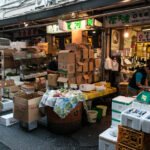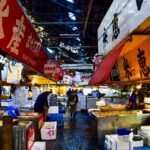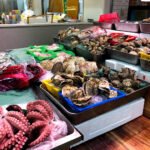Exploring Tsukiji Market: 築地市場 Japan’s Iconic Fish Market and Cultural Hub
Introduction
Tsukiji Market, once the largest fish market in the world, is a must-visit destination in Tokyo, Japan. Known for its fresh seafood, vibrant atmosphere, and rich history, Tsukiji attracts both tourists and culinary professionals. While the inner wholesale market relocated to Toyosu in 2018, the outer market remains bustling with shops and restaurants, making it a perfect place to explore Japanese food culture.
◆ Basic Information’s:
 Address: 〒104-0045 Tokyo, Chuo City, Tsukiji, 4 Chome および6丁目一部
Address: 〒104-0045 Tokyo, Chuo City, Tsukiji, 4 Chome および6丁目一部 Website: https://www.tsukiji.or.jp/
Website: https://www.tsukiji.or.jp/ Website: https://www.tsukiji.or.jp/english/
Website: https://www.tsukiji.or.jp/english/ Directions: google.com/maps
Directions: google.com/maps Admission: Tsukiji Outer Market (Free)
Admission: Tsukiji Outer Market (Free) Phone: 03-3541-9444
Phone: 03-3541-9444




 Opening hours:
Opening hours: - Tsukiji Outer Market::
Monday : 6 AM–2 PM
Tuesday : 6 AM–2 PM
Wednesday : 10 AM–2 PM
Thursday : 6 AM–2 PM
Friday : 6 AM–2 PM
Saturday : 6 AM–2 PM
Sunday : 10 AM–2 PM(The Emperor’s Birthday (Observed))
Tsukiji Market: Image Gallery
1. Historical Overview of Tsukiji Market
Early Origins
Establishment: Tsukiji Market was established in 1935 to centralize Tokyo’s seafood trade, replacing older markets destroyed in the Great Kanto Earthquake of 1923.
Name Meaning: “Tsukiji” means “reclaimed land,” referencing the land reclaimed from Tokyo Bay.
Evolution Over the Years
Tsukiji grew into the world’s largest fish market, handling over 700,000 metric tons of seafood annually.
It became famous for its early morning tuna auctions and wide variety of seafood.
Relocation to Toyosu
In October 2018, the inner wholesale market moved to Toyosu Market to improve hygiene standards and modernize facilities.
Despite the relocation, Tsukiji’s outer market continues to thrive with over 400 shops and restaurants.
2. Tsukiji Outer Market: A Culinary Paradise
Market Layout
The outer market consists of narrow alleys filled with:
Fresh seafood vendors
Produce stalls
Kitchenware shops
Eateries serving sushi, grilled seafood, and Japanese street food
Must-Visit Spots
Sushi Dai and Daiwa Sushi: Renowned sushi restaurants with fresh offerings.
Namiyoke Inari Shrine: A spiritual spot providing protection to market workers.
Tsukiji Uogashi: A modern facility offering fresh seafood and local delicacies.
Popular Foods to Try
Fresh sushi and sashimi
Tamagoyaki (Japanese omelet)
Grilled scallops and seafood skewers
Uni (sea urchin) and toro (fatty tuna)
3. Tour Information and Visitor Tips
Guided Tours
Several companies offer Tsukiji Market tours, providing insights into:
Market history
Seafood handling techniques
Best food stalls to visit
Some tours include cooking classes or sushi-making experiences.
Best Times to Visit
Morning hours (7 AM – 11 AM): Ideal for fresh seafood and less crowded conditions.
Weekdays are generally less busy than weekends.
Visitor Etiquette
Respect vendors: Ask before taking photos.
Mind your surroundings: The market can be crowded; avoid blocking pathways.
Cash is king: Many stalls only accept cash, so carry yen.
4. Cultural Significance of Tsukiji Market
Tsukiji represents more than just seafood; it’s a symbol of Tokyo’s culinary heritage.
The market fosters a community spirit, with multi-generational family-run stalls.
Events and festivals, like the Namiyoke Shrine Festival, celebrate its cultural importance.
5. How to Get There
Location: Chuo City, Tokyo
Nearest Stations:
Tsukiji Station (Tokyo Metro Hibiya Line)
Shijo-mae Station (for Toyosu Market visits)
The outer market is within walking distance from Tsukiji Station (Exit 1).
Conclusion
Tsukiji Market remains a vibrant hub for food lovers and cultural explorers. Whether you’re savoring fresh sushi, shopping for kitchenware, or soaking in the market’s lively atmosphere, Tsukiji offers a unique glimpse into Japan’s rich culinary traditions. A visit here is a must for anyone wanting to experience authentic Japanese food culture firsthand.

![Tsukiji Market [ 築地市場 ] (Fish market)](https://japantourplaces.com/wp-content/uploads/2025/02/Tsukiji-Market-築地市場-Fish-market.jpg)









